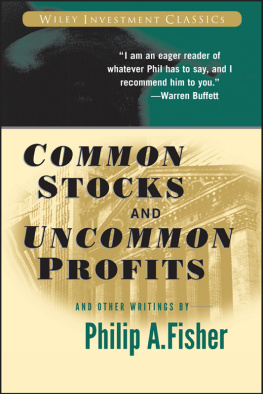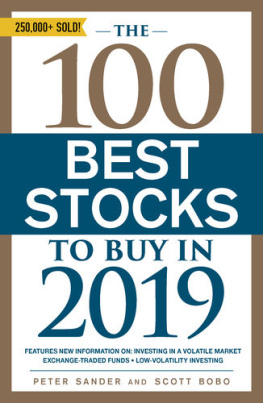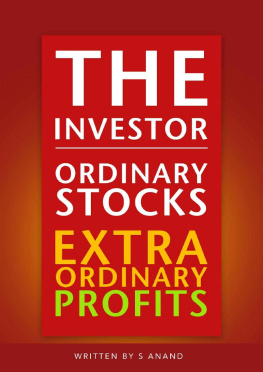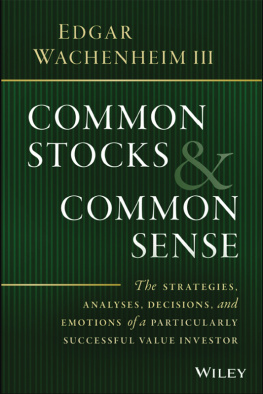Philip A. Fisher - Common Stocks and Uncommon Profits and Other Writings
Here you can read online Philip A. Fisher - Common Stocks and Uncommon Profits and Other Writings full text of the book (entire story) in english for free. Download pdf and epub, get meaning, cover and reviews about this ebook. year: 2015, publisher: Wiley, genre: Art. Description of the work, (preface) as well as reviews are available. Best literature library LitArk.com created for fans of good reading and offers a wide selection of genres:
Romance novel
Science fiction
Adventure
Detective
Science
History
Home and family
Prose
Art
Politics
Computer
Non-fiction
Religion
Business
Children
Humor
Choose a favorite category and find really read worthwhile books. Enjoy immersion in the world of imagination, feel the emotions of the characters or learn something new for yourself, make an fascinating discovery.
- Book:Common Stocks and Uncommon Profits and Other Writings
- Author:
- Publisher:Wiley
- Genre:
- Year:2015
- Rating:5 / 5
- Favourites:Add to favourites
- Your mark:
- 100
- 1
- 2
- 3
- 4
- 5
Common Stocks and Uncommon Profits and Other Writings: summary, description and annotation
We offer to read an annotation, description, summary or preface (depends on what the author of the book "Common Stocks and Uncommon Profits and Other Writings" wrote himself). If you haven't found the necessary information about the book — write in the comments, we will try to find it.
Common Stocks and Uncommon Profits and Other Writings — read online for free the complete book (whole text) full work
Below is the text of the book, divided by pages. System saving the place of the last page read, allows you to conveniently read the book "Common Stocks and Uncommon Profits and Other Writings" online for free, without having to search again every time where you left off. Put a bookmark, and you can go to the page where you finished reading at any time.
Font size:
Interval:
Bookmark:

There are certain books that have redefined the way we see the worlds of finance and investingbooks that deserve a place on every investor's shelf. Wiley Investment Classics will introduce you to these memorable books, which are just as relevant and vital today as when they were first published. Open a Wiley Investment Classic and rediscover the proven strategies, market philosophies, and definitive techniques that continue to stand the test of time.
PHILIP A. FISHER

Copyright 1996, 2003 by Philip A. Fisher. All rights reserved.
Published by John Wiley & Sons, Inc., Hoboken, New Jersey. Published simultaneously in Canada.
No part of this publication may be reproduced, stored in a retrieval system, or transmitted in any form or by any means, electronic, mechanical, photocopying, recording, scanning, or otherwise, except as permitted under Section 107 or 108 of the 1976 United States Copyright Act, without either the prior written permission of the Publisher, or authorization through payment of the appropriate per-copy fee to the Copyright Clearance Center, Inc., 222 Rosewood Drive, Danvers, MA 01923, 978-750-8400, fax 978-750-4470, or on the web at www.copyright.com. Requests to the Publisher for permission should be addressed to the Permissions Department, JohnWiley &Sons, Inc., 111 River Street, Hoboken, NJ 07030, 201-748-6011, fax 201-748-6008, e-mail: permcoordinator@wiley.com.
Limit of Liability/Disclaimer of Warranty:While the publisher and author have used their best efforts in preparing this book, they make no representations or warranties with respect to the accuracy or completeness of the contents of this book and specifically disclaim any implied warranties of merchantability or fitness for a particular purpose. No warranty may be created or extended by sales representatives or written sales materials. The advice and strategies contained herein may not be suitable for your situation.You should consult with a professional where appropriate. Neither the publisher nor author shall be liable for any loss of profit or any other commercial damages, including but not limited to special, incidental, consequential, or other damages.
For general information on our other products and services, or technical support, please contact our Customer Care Department within the United States at 800-762-2974, outside the United States at 317-572-3993 or fax 317-572-4002.
Wiley also publishes its books in a variety of electronic formats. Some content that appears in print may not be available in electronic books.
For more information about Wiley products, visit our web site at www.wiley.com.
Library of Congress Cataloging-in-Publication Data:
Fisher, Philip A.
Common stocks and uncommon profits and other writings / by Philip A. Fisher. p. cm. (Wiley investment classic)
Originally published: Common stocks and uncommon profits. Harper & Brothers, 1958.
Includes index.
ISBN 0-471-44550-9
1. Stocks. 2. Investments. I. Fisher, Philip A. Common stocks and uncommon
profits. II.Title. III. Series.
HG4661.F5 1996
332.83'223dc20
95-51449
This book is dedicated
to all investors, large and small,
who do NOT adhere to the philosophy:
I have already made up my mind,
don't confuse me with facts.
What I Learned from My Father's Writings
This book grows on you. I know because it grew on me. It took me about fifteen years to understand Common Stocks and Uncommon Profits.When I first read the book, it made darned little sense. I was eight. It was a waste of the start of a perfectly good summer vacation.Too many big words that required I use a dictionaryugh. But it was my father's book, and I was proud of him. I had heard at school and from neigh-bors and had read in the local paper that his book was making a big splash. I was told that it was the very first investment book ever to have made the New York Times bestseller list, whatever that meant. I felt it was my absolute duty to read it. So I did, and when completed, I was glad to be finished and free for the summer.
Who knew that I would later go on to found a large investment management firm serving thousands of clients, write my own books, and become the sixth-longest-running columnist in Forbes magazine's formidable eighty-plus-year history or that I would write numerous annual Best of the Year investment book reviews and recommend dozens of books over the decades to readers? And, yes, maybe it helped in route that I could say I'd read my first investment book when I was eight, even if I didn't understand it.
The book next seriously crossed my mind at age twenty as I faced college graduation. Father had offered me a job working with him and my older brother. Anxious, but skeptical, I was curious to see if this job was really an opportunity. So, I read Common Stocks and Uncommon Profits again. (There were only a few words I didn't understand this time.)
Reading about my father's fifteen points to look for in a stock, I wondered if I could apply them to a local stock. If so, I thought this would affirm the benefit of working with my father.
Well, it didn't work.There was a local publicly-traded lumber stock, Pacific Lumber, that looked like a good profit opportunity. But the few folks I approached weren't impressed with some wanna-be kid-sleuth seeking competitive detail who was clearly ill-prepared to analyze or do anything with it. I didn't even know how to ask meaningful questions. After being shut out by the first few folks I approached with my fact- seeking questions, I gave up. But it showed me that I needed quite a bit of polishing.
Working for my father was a bumpy ride, a bit like my first professional stock purchasea reverse ten bagger: it fell from ten to one. I tell you all this only so you can see that even a kid in his twenties, without a lifetime at the top of his school class, having never attended a big-name university, and with no major accomplishments under his belt to brag on, even that kid could go on and in just a few years learn to effectively use the principles in this book. And so can you.
Ultimately, when you're a young man starting out in the industry as I was and haven't yet bought any stocks, figuring out what to buy seems immediately more important than figuring out what to sell. Fortunately, this book teaches that if you figure out the right things to buy, selling becomes a lot less important because you can hold the stocks you own longer. And what to buy derives directly from my father's fifteen points.
Applying his fifteen points was a repeatable real-world experience linked to scuttlebutt, as he described it, all aimed at researching one stock here, another there. And it worked. I will not here recount in detail the successes that the fifteen points helped me achieve early in my career. But I gained tremendous career momentum by discovering a handful of great stocks that did wonderful things for me. From the fifteen points, I could fathom generally where a firm fit into the world and how it would or wouldn't prosper. If it wouldn't, what might its hiccups be? I soon understood why my college try at the fifteen points failed. The craft is in the scuttlebutt, which, like all craft, takes time to learn. Scuttlebutt is simply about finding out from real, Main Street sources if a firm is strong or weak. Most folks don't use this approach, relying instead on the local rumor mill and Wall Street noise, most of which is aimed at selling you product.
Next pageFont size:
Interval:
Bookmark:
Similar books «Common Stocks and Uncommon Profits and Other Writings»
Look at similar books to Common Stocks and Uncommon Profits and Other Writings. We have selected literature similar in name and meaning in the hope of providing readers with more options to find new, interesting, not yet read works.
Discussion, reviews of the book Common Stocks and Uncommon Profits and Other Writings and just readers' own opinions. Leave your comments, write what you think about the work, its meaning or the main characters. Specify what exactly you liked and what you didn't like, and why you think so.









